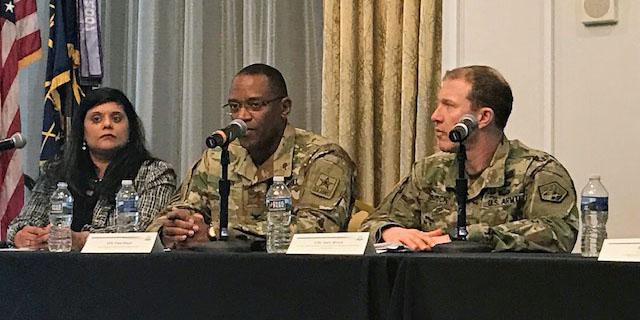New Army Programs of Record Emphasize Cyber
Confronting adversaries on a more complicated battlefield requires advanced tools for a U.S. Army more comfortable operating in the traditional domains of land, sea, air and space. The new Cyber Situational Understanding program of record, however, will give the U.S. Army an increased understanding with actionable information of the cyber domain, explained Portia Crowe, chief, Cyber Engineering at the Army’s Program Executive Office Command Control Communications – Tactical (PEO C3T).
Crowe headed up the AFCEA Aberdeen Chapter’s 4th Annual C4ISR Cyber Panel on March 6 and spoke to SIGNAL Magazine in an interview.
“We have a new program of record called Cyber Situational Understanding, and part of that effort links network awareness and mission awareness together,” she said. “We are in the planning stages in which we are following the guidance of Army Cyber Command, so we are working across stakeholders to potentially include electronic warfare and information operations.”
As the chief of Cyber Engineering, a role she has been in for about two and a half years, Crowe has to maintain the engineering discipline of cybersecurity for all of PEO C3T’s 24 key acquisition programs, as well as any future programs. “We have to ensure that we bake in cybersecurity early and often during the development, testing and experimentation of those programs,” Crowe noted.
This includes efforts in another new program of record, the Command Post Computing Environment. The CP CE, as it is known, is an integrated mission command software and hardware system that will support warfighting applications across intelligence, fires, logistics, maneuvers and airspace management capabilities. It is the most critical computing environment developed to support Army command posts in combat operations, according to PEO C3T. It provides command and control, critical situational awareness capabilities, with a comprehensive data approach.
Cyber tools, including the Cyber Situational Understanding capability, as well as other defensive cyberspace activities, will utilize the CP CE framework, said Crowe, who was previously the chief engineer of CP CE. “The information from Cyber Situational Understanding will feed into the CP CE framework so that we have one common operating picture (COP), because we still want to maintain one COP for commanders and staff,” she stated. “To support commander decisions, we need to integrate cyberspace critical information onto a single COP, so that we create an intelligent visualization asset that includes an understanding of what's happening in cyberspace to support multidomain operations.”
In building a Cyber Situational Understanding tool with the CP CE platform, the biggest challenge is integration, Crowe continued. “This is a very large integration effort because you're ingesting data from various sources, such as electromagnetic sensors, spectrum, friendly and adversarial data and network operations, even gray space, and you're fusing all that data together to make sense of what is happening, or could happen, to impact the mission with an intelligent risk assessment.
For its command, control, communications, computers, intelligence, surveillance and reconnaissance (C4ISR) and electronic warfare (EW) capabilities, PEO C3T also is implementing the C4ISR/EW Modular Open Suite of Standards, referred to as CMOSS. Developed by the C5ISR Center at the Army’s Combat Capabilities Development Command (CCDC), formerly known as the Communications-Electronics Research, Development and Engineering Center, CMOSS allows the communication components of military vehicles to share a common platform. The open architecture applies a necessary Army baseline as well as industry standards, to make sure that the Army technology solutions are standardized.
“Standards are not sexy,” Crowe laughed. “But it is important because that is going to be the new standard to how we want industry to bring solutions back to us, whether that's radios, chip sets, hardware, etc. So it's important that we all understand what those standards look like.”
The PEO C3T is hosting a Mission Command Industry Forum in Baltimore on March 19-20, giving industry a chance to discuss CMOSS with Army leaders. The leaders—such as Maj. Gen. David Bassett, USA, the PEO C3T program executive officer; Maj. Gen. Peter Gallagher, USA, director, Network Cross-Functional Team (Network CFT); Maj. Gen. John Morrison, USA, commanding general, the Army Cyber Center of Excellence, and commanding general, Fort Gordon; and Maj. Gen. Doug Crissman, USA, commanding general, Mission Command Center of Excellence—will also be reviewing the technical and acquisition approach to the Cyber Situational Understanding program and the CP CE, including timelines and industry opportunities.
In addition, PEO C3T is busy at work on distributed cloud computing. Crowe explained that the office is partnering with the Network CFT and the Army CIO/G6 to “explore cloud computing with mission command services so that we can utilize industry innovations to explore tactical hardware basis of issue changes, increased cybersecurity, as well as cloud-hosted training environments for 24/7 accessible learning.”
Furthermore, to leverage the information coming in at the tactical level, the office is developing “an all encompassing” data strategy, Crowe added. “We're building towards a data strategy that will increase our ability to share data and incorporate artificial intelligence (AI) and deep learning applications, so we can recognize anomalies in behavior patterns and conduct predictive analysis to help inform commanders of potential adversarial activities,” she said.
Gen. Matthew Easley, USA, director of AI, Army Futures Command, has called for innovative technologies, and PEO C3T is putting together some AI-use cases to apply with “some of our more richer elements of data,” Crowe shared.
This week, some of the generals will be speaking to Signal leaders and the industry at AFCEA’s Army Signal Conference, "The Network in an Era of Great Power Competition," in Springfield, Virginia, March 12-15.





Comment
Good article Kimberly! thanks
Good article Kimberly! thanks for covering the Aberdeen AFCEA Event.
Comments